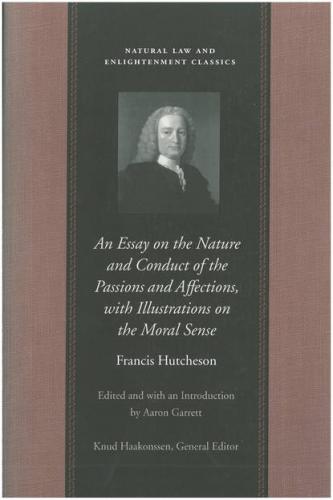[print edition page i]
AN ESSAY ON THE NATURE AND CONDUCT OF THE PASSIONS AND AFFECTIONS, WITH ILLUSTRATIONS ON THE MORAL SENSE
[print edition page ii]
NATURAL LAW AND ENLIGHTENMENT CLASSICS
Knud Haakonssen
General Editor
[print edition page iii]
[print edition page iv]
[print edition page v]
[print edition page vi]
This book is published by Liberty Fund, Inc., a foundation established to encourage study of the ideal of a society of free and responsible individuals.
The cuneiform inscription that serves as our logo and as a design element in Liberty Fund books is the earliest-known written appearance of the word “freedom” (amagi), or “liberty.” It is taken from a clay document written about 2300 B.C. in the Sumerian city-state of Lagash.
Introduction, annotations, textual notes, index © 2002 by Liberty Fund, Inc.
Cover image: Detail of portrait of Francis Hutcheson by Allan Ramsay (c. 1740–45), oil on canvas, reproduced courtesy of the Hunterian Art Gallery, University of Glasgow.
Margin notes have been moved from the margin of the paragraph in the print edition to precede the paragraph in this eBook, in a smaller font.
This eBook edition published in 2014.
eBook ISBNs:
978-1-61487-044-9
978-1-61487-192-7
[print edition page vii]
CONTENTS
[print edition page viii]
[print edition page ix]
An Essay on the Nature and Conduct of the Passions and Affections, with Illustrations on the Moral Sense (1728), jointly with Francis Hutcheson’s earlier work Inquiry into the Original of Our Ideas of Beauty and Virtue (1725),1 presents one of the most original and wide-ranging moral philosophies of the eighteenth century. These two works, each comprising two semiautonomous treatises,2 were widely translated and vastly influential throughout the eighteenth century in England, continental Europe, and America.
The two works had their greatest impact in Scotland and influenced many well-known Scottish philosophers, particularly those writing after the last Jacobite upheaval, in 1745. This can be seen in the concern of the post-1745 generation with analyzing human nature as the foundation of moral theory, with the “moral sense” and moral epistemology more generally, with the impartial spectator and the calm passions, and with the independence of benevolence from self-interest. In addition to the influence of his writings, Hutcheson was also a famed teacher whose Glasgow students, notably Adam Smith, held sway over generations of Scottish moral philosophers.
Despite their impact on Scottish letters, the four treatises were in fact written in Dublin, and the philosophers to whom Hutcheson responded
[print edition page x]
and with whom he debated were in the main not Scottish but English, Irish, French, Roman, and Greek. Consequently, part of Hutcheson’s legacy was a cosmopolitan outlook among enlightened Scots, who learned to turn their eyes far from home.
Early Life
Hutcheson was born in 16943 in County Down, near Saintfield. His father and grandfather were respected Presbyterian ministers in the Scots emigrant community of Ulster. Unlike their brethren in Scotland, where the Presbyterian Kirk was the established church, the Irish Presbyterians were Dissenters. Like the English Dissenters, they were discriminated against by the Anglican state church, which considered them marginally less unsavory than Catholics.4 They were excluded from Trinity College, Dublin, as well as from Oxford and Cambridge, and, after 1704, they could not take public office.5 The major difference between Irish Presbyterians and English Dissenters was that the former had strong ties to Scotland, including the Scottish universities, especially Glasgow.
Irish Presbyterians were divided between traditionalists and more rationally inclined “New Light” ministers. John Hutcheson, Francis’s father, was a traditionalist who wrote the church’s response to the claims of “liberal” nonsubscribers. Francis associated with the nonsubscribing
[print edition page xi]
clergymen in Belfast and leaned toward the tolerationist theology of love that was associated with the New Light.6.
Hutcheson was schooled in classics in Ireland and moved to Glasgow in 1711 when the university was just recovering from a period of decline, thanks to the influence of some charismatic and theologically moderate teachers and of politically active Irish students who challenged the arbitrariness of university authority.7 Upon graduating, Hutcheson returned to Ireland to head a Dissenting Academy in Dublin, a major undertaking of the Ulster Kirk in which he appears to have prospered. Hutcheson associated with Robert Molesworth, a close friend of Shaftesbury and of radical intellectuals such as John Toland and Anthony Collins. In Ireland, Molesworth cultivated a circle of talented intellectuals who wrote in the Dublin Journal, notably Hutcheson’s friend James Arbuckle. Hutcheson was also in contact with open-minded Anglican intellectuals such as William King, the archbishop of Dublin. At the same time, Hutcheson no doubt felt the impact of the more bigoted world about him.
In intellectual circles, clubs, and, particularly, publications such as the Dublin Journal and the London Journal, provincial intellectuals flourished, fought, and exchanged ideas. Like Bayle’s Rotterdam, with its Huguenot diaspora, Hutcheson’s Dublin felt the weight of sectarian controversy and the tug of another country. In this context Hutcheson wrote his early masterpieces.
The Inquiry
Treatise 1, the Inquiry on Beauty, is relatively independent of the Essay with Illustrations except that it presents the sense of the “beautiful” as a model for Hutcheson’s subsequent considerations of the “internal” senses. Treatise 2, however, is presupposed in the Essay with Illustrations (see the Preface). The first section of Treatise 2 considers the moral
[print edition page xii]
sense, and the validity and the importance of the arguments for it in Treatise 2 are assumed in Treatises 3 and 4.
Hutcheson’s basic premise—in both the Inquiry and the Essay—is that our immediate perceptions of the moral qualities of an action or a character are derived from a “sense,” like the external senses, that perceives external, adventitious qualities. To this end, Hutcheson argued that the content of a moral perception, the quality perceived, cannot be forced upon
